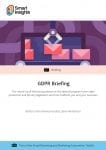6 emerging email and marketing automation trends to help inform your 2018 email marketing communications strategy
Email marketing continues to be a vital communications channel with the DMAs latest Email tracker showing that email receives 30 times return on investment on average. 95% of respondents rated it as 'important' or 'very important' to their organization.
Yet competition in the inbox for attention from email subscribers remains fierce as social media remains important and competitors optimise their approach.
Download FREE Resource – Email trends 2018: A visual guide
Review your approach to email marketing by reviewing the latest trends.
Access the
So, it's important to review the success factors to improving email ROI, which we summarise in this article with the help of the email specialists who kindly contributed their views and predictions on the trends which will be important in 2018. While some of these are not 'new' techniques, they are increasing in adoption since they are vital to keeping up with your competition and engaging your audience further in the customer lifecycle.
Our lifecycle marketing model shows you the potential customer touchpoints and how email marketing aids in increasing relevance and response of communications. Marketing activities such as personalization, loyalty programs, and re-engagement email programs are vital to your email marketing strategy. Whilst SEO, PPC, social media, and advertising may contribute to getting your customer into the top of your sales funnel, it is essentially your email marketers that keep them there, increase repeat purchase and increase customer-brand engagement.
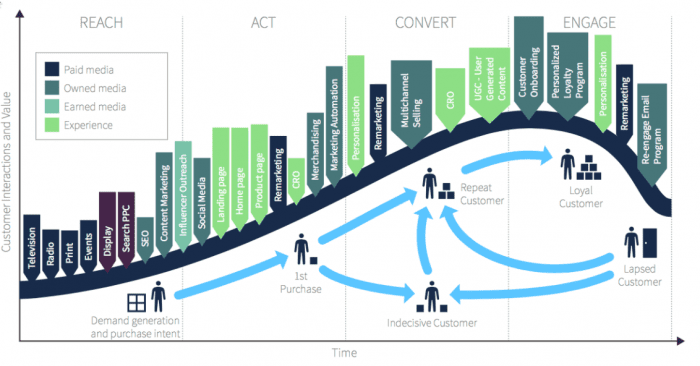
For a broader overview of the biggest digital trends, including the integration of customer journeys into your engagement strategy, check our Dr Dave Chaffey's 10 marketing trends to act on in 2018.
With the end of 2017 drawing near, the trends in this article reflect on our free resource, Email Trends 2017 - a visual guide, to see if our predictions matched up to what the landscape of email looked like this past year.
Which techniques are already part of current email marketing activities?
The Email Marketing Industry Census 2017, by Econsultancy in association with Adestra, shows that segmentation (80%) remains the highest priority and technique used in email marketing campaigns in 2017. However, this is only a 1% increase from 2016 showing very little businesses are adopting this technique further than what they were in 2016.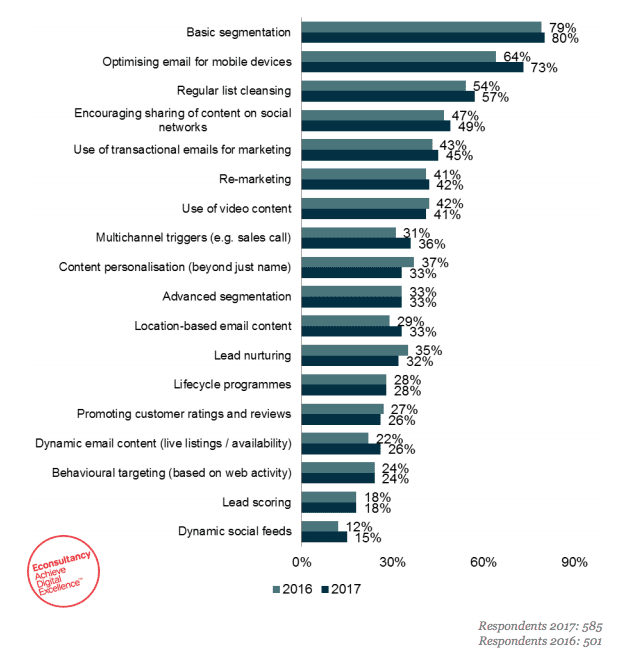
Optimizing emails for mobile had the highest increase (9%) showing adoption of this technique is becoming increasingly popular and important for retention, UX and engagement on on-the-go devices for quicker and more convenient consumption of content. Other techniques with an increase in importance were:
- Encouraging social sharing (2% increase)
- Transactional Emails (2% increase)
- Location-based emails (4% increase)
- Dynamic content and dynamic social feeds (4% and 3% increase)
I will be addressing the importance of mobile-responsive emails, amongst other important trending features:
- Respecting personal data will change your email marketing strategy
- Mailable 'Microsites' are adopted by more companies to increase customer research, engagement, and retention
- Conversion tones are adopted to increase genuine human interaction with customers
- Rending is addressed to improve UX across email clients
- Personalization and segmentation remain a priority to share dynamic content
However, it is interesting to note that personalization is a technique that has decreased in popularity by 4% (beyond adding in the user's name). Whereas this was a rising email trend a couple of years ago, it is hard to show how it has progressed further. More is needed than customizing the email to include the users' names. This has become the standard practice and is no longer considered 'personal', users now expect to see their name, anything less is offputting and risks low engagement.
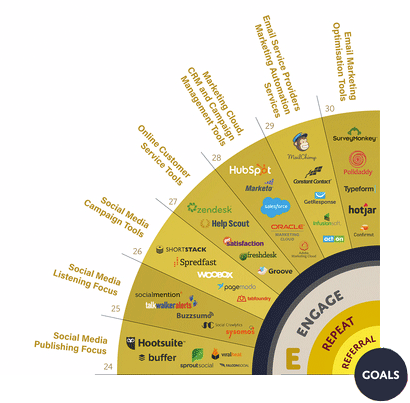
Whilst email competes with organic (SEO) and paid search (PPC), it can drive a higher volume of sales than other channels and is important for customer acquisition, engagement, and retention. In our Essential Digital Marketing Tools framework, we outline the insight and management tools to help you engage users via marketing automation and optimization tools.
Expert prediction

Paul de Fombelle - International Business Development Director, Mailify
A major trend in email marketing in 2018 (like these past years...) will be to describe it with data biased by the largest retailers' influence. As they send millions of emails daily, their practices are highly visible but, in fact, email marketing senders are primarily small and medium businesses (SMBs), millions of them.
Therefore, to me the most important trend is how those SMBs are stepping up their game in the email marketing world. In the past years, they first learnt the existence and the multiple advantages of the channel, including the high ROI. They started doing email marketing. Then they understood that email marketing is the most efficient channel when it’s done in an appropriate way: they understood spam does not pay back, and that messages need to bring value. They started doing good email marketing. Now, in 2018, the main trend will be to see those small businesses start implementing advanced practices that were until then almost exclusively adopted by large accounts: a/b testing, multi-channel campaigns, automated communication flows, etc.
It will be incredibly interesting to see how those advanced email marketing practices optimize the benefits that the channel offers them. Nevertheless, we know that the recipe for success will not change, being the key ingredients a qualified lead generation process, a well-thought recipient segmentation, a relevant message and well-designed, responsive email newsletter templates and, last but not least, the reputation and efficiency of a well-chosen email marketing app able to deliver.

Jordie van Rijn - Email Marketing and eCRM Consultant, Author, and Founder of Email Vendors Selection
Instead of trying to employ email at every twist and turn of the customer journey, it is often more effective to focus on the well performing campaigns. We need to learn to “Carpe Conversion”, tune to their mindset and deepen the personalized contact at those moments that matter.
One way that is up and coming in 2018, will be the combination of email and on-site interactions. Interactions with chatbots, guided tours, and next best action slide-ins. You know the little dialog boxes and circles bottom-right to click on? We will see a shift, as companies are starting to use them to guide the customer into (opt-in) and from (after click through) email and continue the flow on the site.
Improving landing page conversions and lead-to-deal ratio is also important.
Trend 1. Respecting personal data will change your email marketing strategy
This isn't a 'trend' as such that marketers are voluntarily adopting but instead enforced by the European Commission May 25, 2018. It's vital to comply with or risk hefty fines.
The way data is collected, stored and used for email campaigns has previously and continuously had a bad reputation due to the negative handling of personal data - often viewed as spam by the recipient. However, as GDPR comes into effect, we will see other counties tightening their data handling procedures, including America's CAN-SPAM.
We recently asked our members 'Is your company GDPR ready?' and found that the majority (94%) were 'aware but haven't started' preparations or didn't know what GDPR is!
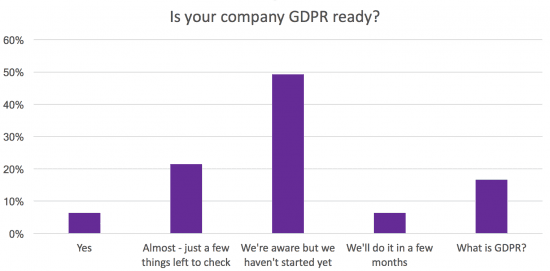
General Data Protection Regulations (GDPR) changes will be enforced in 6 months, affecting all businesses that market to customers in all 28 European counties. This is the biggest change happening that affects email marketing strategies in 2018. For many years obtaining email addresses, phone numbers and other personal contact details via competitions and promotion of free whitepapers has been a technique to increase contact databases, used afterward for email re-engagement campaigns that the user had not originally and explicitly consented to. Reconsent needs to be given to store and use personal data.
With this change, we will see companies tightening up their use of personal data. This change will hopefully decrease the negative stigma that has built up around company email campaigns and the amount of spam users receive.
Our email marketing manager has produced a practical guide, with checklists, to help inform you about GDPR, what needs to be done and how / if this affects you.
Download Premium Resource – GDPR briefing guide
Our round-up of the best guidance on the latest European Union data protection and privacy legislation and how it affects you and your business Are you ready for the GDPR? The GDPR (General Data Protection Regulation (Regulation (EU) 2016/679) comes into force in all 28 countries in Europe on 25th May 2018. It has been agreed by the EU in this directive and how it must be implemented to remain compliant differs according to interpretation in different countries.
Access the GDPR and ePrivacy briefing for marketing professionals
What do marketers need to do in 2018 to comply with GDPR changes?
- Processing of data is done lawfully and fairly,
- data is collected for explicit legitimate purposes
- making sure the data is adequate, accurate, and
- retained for only as long as necessary.
- processed in a manner that maintains the integrity and confidentiality of the personal data.
In conclusion, GDPR is all about transparency and individual rights - use of personal data will be handled with more respect and this will have a positive effect on email campaigns.
Expert prediction

Tim Watson, Email Marketing consultant at Zettasphere
For email and just about any other marketing the big thing in 2018 is GDPR in May. This is going to be very disruptive if not terminal for email 3rd party data. For continued strong first party list growth new persuasive methods for opt-in consent are going to be needed. There could be more innovation in list growth this year than for the last 14 years; since the introduction of PECR regulation in 2003, when the pre-ticked box became just about universal.

Joolz Joseph - Strategic Email Marketing Consultant - The Virtual Marketeer
Data wise it’ll be about leaner, cleaner lists as emailers respond to GDPR by removing non-compliant data and tightening opt-in procedures. There will likely be a rush of repermissioning emails end of Q1 around this as reality starts to hit.
Process-wise, the continuing rise of automation for all email marketers right down to microbusinesses. It is now available with even the lowest cost services and working with smaller businesses those marketers are looking to drive timely, relevant communications more than ever and have finally woken up to automation.
Creatively, interactivity in emails whether it’s eye-catching image carousels or the ability for recipients to act from within the email using integrated surveys or forms.
Trend 2. Mailable 'Microsites' are adopted by more companies to increase customer research, engagement, and retention
A mailable 'microsite' is an interactive email, which allows the user to interact with the email interface within the inbox. The adoption of this technique will help retain customers and give a more engaging approach to content. Interactive emails keep the inbox interesting and unique.
Features of an interactive email may include, but not limited to:
- Integrated forms and surveys: done 'in the inbox' without directing them to a separate online landing page
- Social sharing: this makes it easier for your user to share content on their social platforms
- Gifs, videos, and animations: this can engage users, but can sometimes lead to inconsistent experiences across email clients (large files will mean a slower download)
- Search in email
- Menu options / navigation bars: integrating these into your emails can increase clicks leading to higher conversions
- Rotational banners / carousels: this encourages interaction with the content, increasing the chances of positive engagement and conversion
- Countdowns: adding in a countdown clock for sales and promotions will alert the recipient of the urgency to take action - this can help give the audience a little nudge to convert, rather than the standard 'offer ends soon' text
Interactive email essentially hands your audience everything they need on a plate - with minimal effort for them. They do not need to divert out of the inbox to view content, interact with video or complete surveys - making it more likely they will interact due to less effort needed to complete a task.
It surprises me that this technique isn't already dominating users' inboxes from the already dull, boring and flat static emails that are sent in surplus. However, until some email clients such as Outlook support these features, it will be hard to fully adopt this technique.
Check out this email sent by Feel Unique, who used gifs in their emails to showcase their new app, how to use it and entice the user to download it.
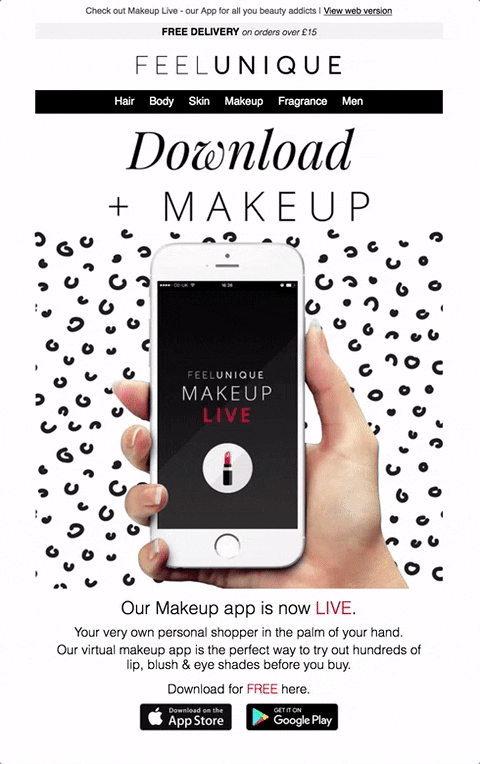
Collecting data from your customers is important in constructing an accurate and detailed customer persona. Asking your audience to fill out surveys and questionnaires is the best way to find out. However, this can be time-consuming to your audience as CTAs direct them to an online landing page to fill out surveys and forms.
But integrated survey and forms will help increase engagement, as users can fill out the form without leaving their inbox. Applications of email surveys include asking your customers to fill out a review of your product or service, what your customers currently like or is trending to personalize content to their needs, promotional emails after purchase to gain consented subscribers etc.
For this to be fully adopted by more companies, email clients will have to have full compatibility with this type of technology. Clients like mobile third-party email apps like Gmail and yahoo) have fallback support. Plus, some email clients are still not compatible with integrated email forms and surveys and still have a long way to go.
EmailMonks built their first ever horror email, influenced by the film Annabelle: Creation (view online). However, it was not built for Outlook as Outlook does not support certain interactive features.
Creating interactive mailable microsites is the future of email marketing. I do believe that when email clients support the use of interactive features, companies that start adopting this technique will see a higher rate of engagement. But for now, it is important to use the technology already available to engage to make sure all your customers receive a professionally created, designed and written email.
Expert prediction

Jaymin Bhuptani - Director, EmailMonks
Interactivity in email is all set to continue its winning spree in 2018. This is evident from the promising trend identified from the steady surge in demand for interactive emails we built for our clients in 2017 – approx. 50% rise than the previous year.
Noticeably, we have seen a major rise of just less than 200% in the use of drop-down navigation in email design.
Moreover, as the need for relevant, personalized content becomes stronger than ever, expect campaigns to become more data-driven. Machine learning will thus play a vital role in the creation of email campaigns in 2018.

Constantine Rozenshtraus-Makarov, Co-Founder and CEO of SendPulse
2018 of emails will be about interaction, gamification, and AI.
In 2018 interactive content based on gamification principles will incentivize users to click and become more involved with the brands. Static emails are no longer enough to catch the eye of the ones who want to play, and so marketers will offer them play.
Email automation AI will not conquer the human race yet, but will continue its expansion to creating attractive subject lines for better open rates and will learn from users' behaviour when is the best time to send emails to them. Follow up to unopened emails will be taken off the human shoulders too.
Growing customer-centric approach in marketing will inspire email marketers to take a deeper dive into user-generated content and to use any data (big data) they possess about customers for generating personalized email content.
Download FREE Resource – Email trends 2018: A visual guide
Review your approach to email marketing by reviewing the latest trends.
Access the
Trend 3. Conversational tone is adopted for more personal interaction with audience
The tone you chose to use in your emails affects the way your customers will respond. A conversational tone may not be the best tone to use across all sectors, but it does give a more personal and genuine interaction between the customer and brand.
A conversational tone will ask your users questions, get them thinking and then give them the answer they need - through your CTA directing them to your content that helps / educates them.
Whereas a more formal approach may be better for B2B sectors, asking questions and starting a conversation with your audience is important for engagement. It will feel more personal show that the content you have produced has had them in mind, feeding their needs for answers, content, products etc.
Trend 4. More businesses push for mobile-friendly design
As shown in the Econsultancy chart, 73% of respondents are prioritizing optimizing email for mobile devices, a 95% increase from 2017 and the biggest for any email trend in the last year. This is only going to increase as the year progresses into 2018.
We now live in a mobile-first society, where content is consumed on the go, in the early morning or late at night via mobile. I myself, check my social notifications and emails on a morning to catch up on the day ahead. It is now more important than ever to make your emails mobile-friendly, after all, why should this medium of marketing be neglected from other mobile-optimized content?
Mobile optimized sites increase loading time, and this counts as an important ranking factor on SEPRs and gives an overall excellent UX for your audience. This is also true for email - slow loading emails that aren't optimized risk low engagement rates and poor clickthroughs, especially if the CTAs have been cut off from the mobile design.
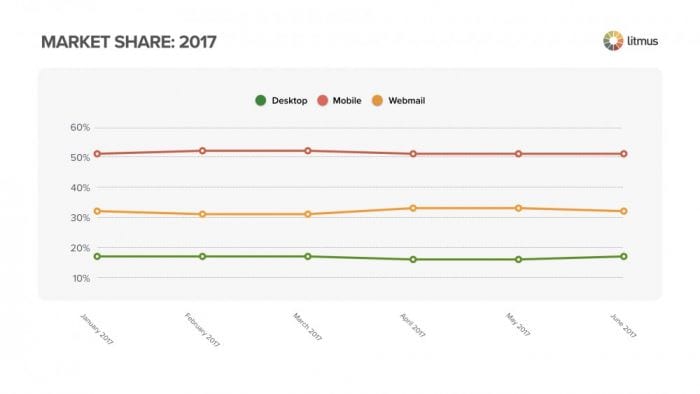
A recent report by Litmus shows what 2017 has taught us about the use of email clients in the past year. Whilst there is a rise in webmail, mainly driven by Gmail, mobile has consistently had the highest market share (50% an over).
However, it is important to know how, when and where your target audience consumes their information. Knowing whether your audience prefers desktop experience or a mobile experience is vital!
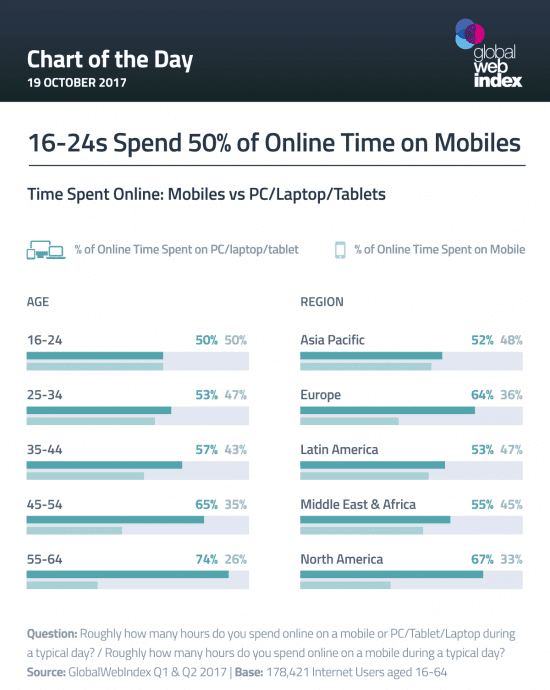
For instance, in a recent research study published by Global Web Index, mobile and desktop both engage 16-24-year-olds with the same amount of time spent online. However, as the age of users increases the time spent on mobile decreases. But, don't forget, as time progresses more and more people will adopt a mobile-first approach, and soon it will be a huge competitor for desktop consumed content as millennials start aging through different age boundaries.
Take a look at Smart Insights' member enewsletter sent out bi-weekly on desktop and how this is optimized for mobile.
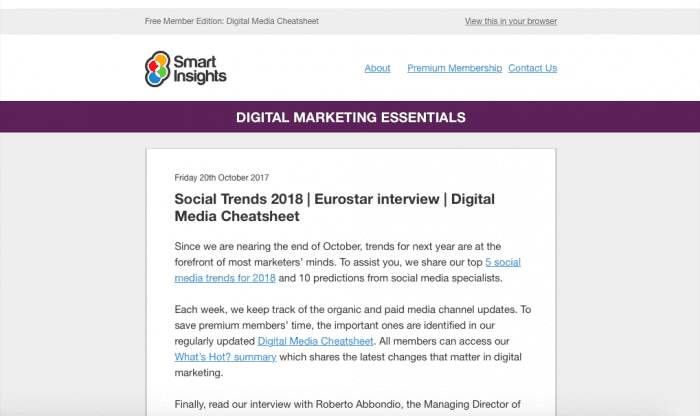
For mobile:
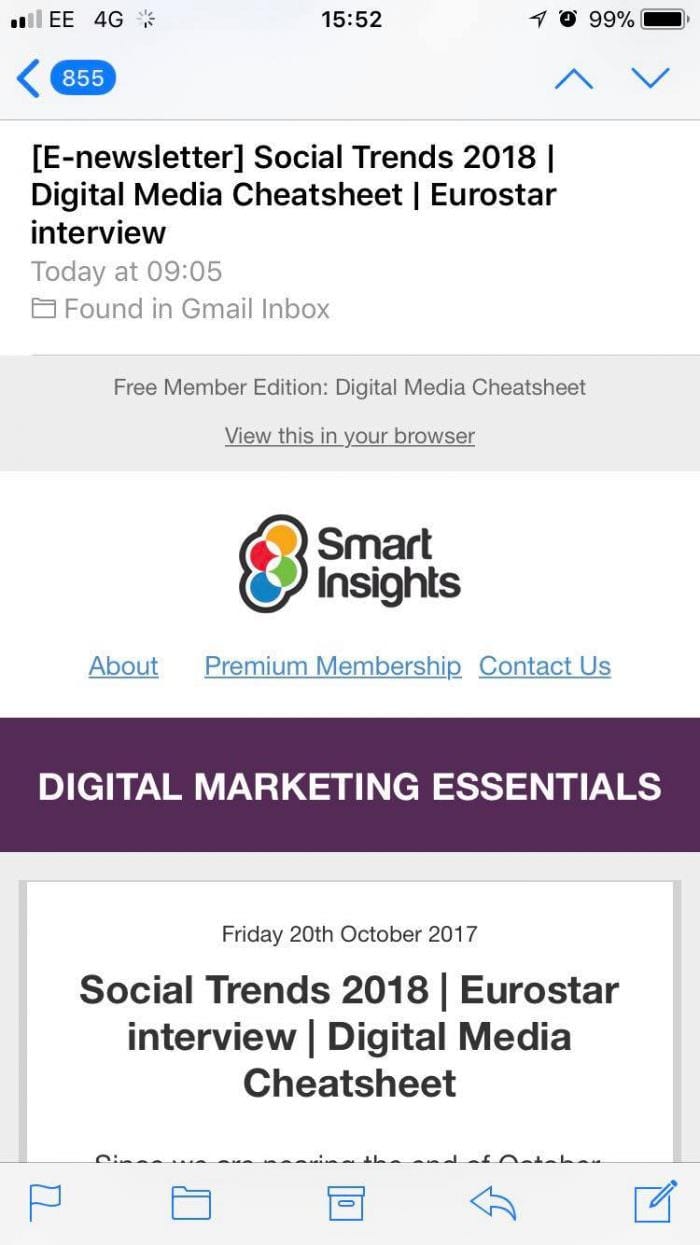
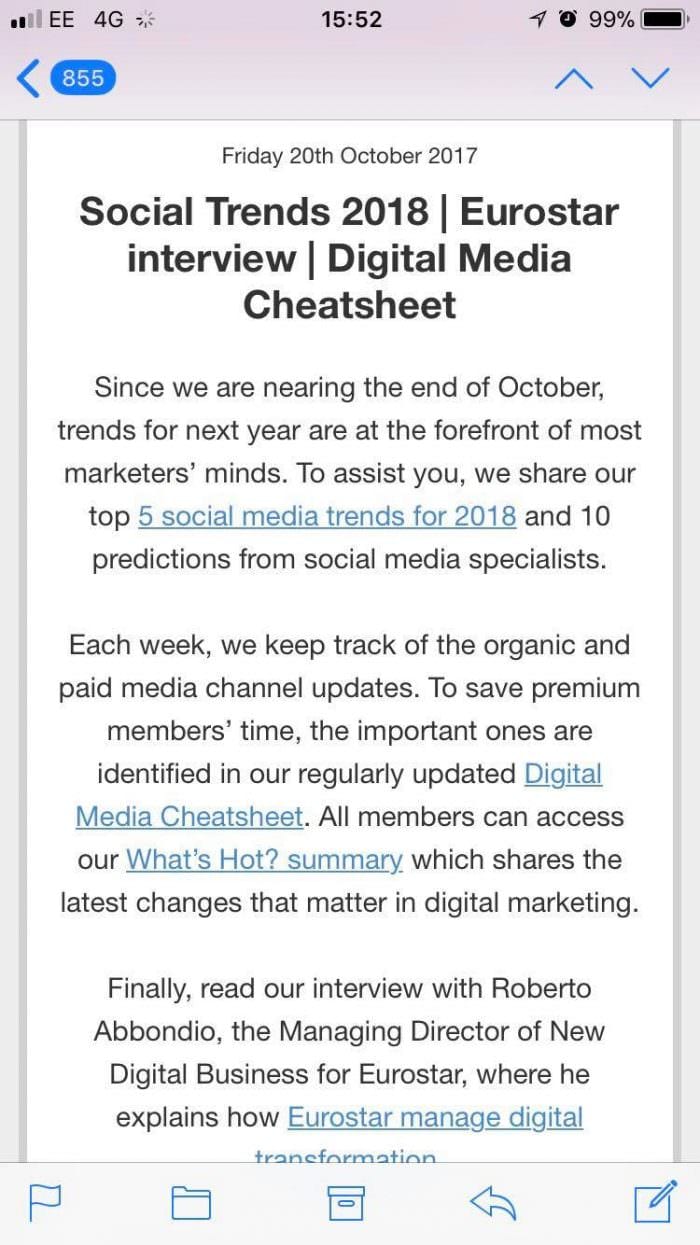
The design is responsive to space it has to fill, easy to read and more importantly easy to scan for those busy marketers on the go.
Trend 5. Testing and deliverability need addressing further
Ultimately, this comes down to the background work your email marketers do to make sure the emails are opened with the correct design and delivered to the correct email folder. Without doing the background work, all the extra effort for design and copy are lost and your customer engagement rate decreases.
Rendering your emails is important to make sure your emails are viewable across all email clients. Taking the time to create a great design and engaging copy is a wasted time when your customer cannot see your amazing work. Rending gives your customer a customized experience, regardless of the email client they use.
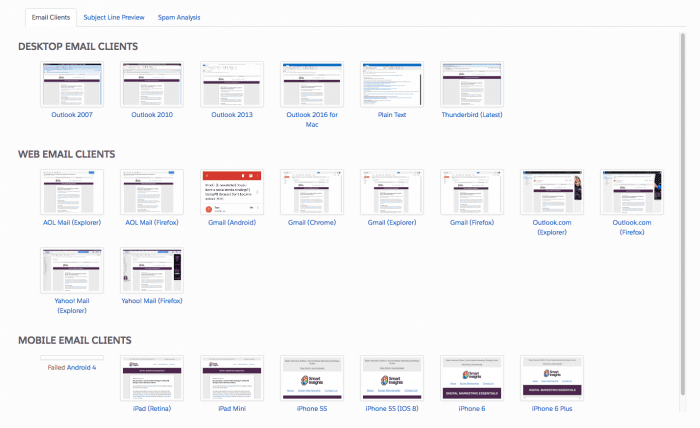
Test your emails to make sure the design is perfective, the images load and the copy is exactly where you want / need it for engagement.
For a long time, deliverability of emails has also been important - going into 2018, our expert commentator, Chad White explains the importance of deliverability in the upcoming year.
Expert prediction
 Chad White - Research Director at Litmus and Author of Email Marketing Rules
Chad White - Research Director at Litmus and Author of Email Marketing Rules
The new thing for email marketing in 2018 will be an old thing: email authentication. The standards for SPF and DKIM authentication are more than a decade old, while DMARC is newer. Despite boosting brands’ deliverability and protecting brands from being accessories to phishing attempts, all three standards see relatively low adoption. Only 69.4% of marketers have adopted SPF; 66.6% DKIM; and 46.5% DMARC, according to Litmus’ State of Email Deliverability report.
Adoption of authentication will surge in 2018 because of the emerging Brand Indicators for Message Identification (BIMI) standard, which will display brand logos next to properly authenticated messages. The carrot of that additional branding in the inbox will spur more brands to finally adopt SPF, DKIM, and DMARC—and reap the other benefits of authentication in the process.
Trend 6. Personalization and segmentation remain a high priority to continue sharing dynamic and engaging content
Dynamic content remains important year-on-year, to create a personalized experience for your customer with more relevant communications. Dynamic content refers to the HTML within your content which changes based on the recipient. This goes hand in hand with segmentation (list / location based emails). Together they provide the user with an email that is customized to them.
This is important creating a unique experience which makes the user feel valued by the company. The most basic and widely used form of personalization is inserting the name of the user into the email, rather than a standard 'dear customer' or a simple 'hi'. But this is no longer enough.
Our machine learning customer lifecycle shows the importance of dynamic content email - it contributes to engagement with loyal customers and lapsed customers. Without dynamic content, you aren't telling your customers why they need to come back or keep buying / interacting with your brand.
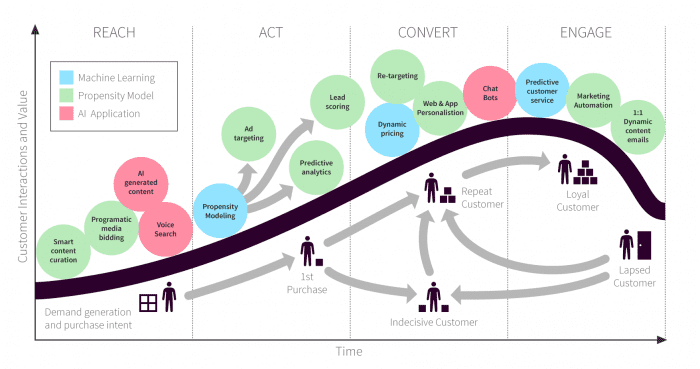
One rising trend we notice email specialists are excited about is the rise in using machine learning to achieve the highest level of personalization for the customer.
Download FREE Resource – Email trends 2018: A visual guide
Review your approach to email marketing by reviewing the latest trends.
Access the
Expert Prediction

Kath Pay, CEO - Holistic Email Marketing
I believe that achieving personalization using machine learning/AI will achieve an uptake in 2018. Email Marketers have struggled for years with manually segmenting lists – mainly because of the time it took, the inaccuracy of doing so (only achieving a one-to-many result) and the ROI being diminished for their efforts the more granular (and therefore the more personalized) they segmented. Likewise, dynamic content never really took off because of the effort required to set it up. Enter machine learning personalization. By using a third-party system, such as Jetlore and other similar solutions which plug into their existing ESP, that are capable of reading, and using web-based descriptions, marketers will not only be able to provide a 1:1 experience for their customers, but also gain valuable insights and predictions of their customer’s behaviour. For a small investment, significant increased conversions can be gained and a superior customer experience can be provided, contributing to increased CLTV.

Lee Davies - Online Marketing Manager, Pure360 (email marketing software)
For me, the key trend in 2018 will around personalization. Not simply ‘Hi {FirstName}’, that doesn’t cut it anymore. Consumers are becoming more clued up with the emails they receive and the content contained within them.
While the classic first name personalization in the subject line or opening line of an email was once a delighter, it’s now become commonplace, and expected, to the point where if you’re not addressing the recipient by their name they may lose trust.
Consumers know that as a brand you’re sending out tens, if not hundreds of thousands of emails in a campaign, but they are also aware that you should now know enough about them to ensure that the content you’re including is relative to them.
If you’re able to recommend products to them based on their purchase history, use social proof to back up suggested purchases, or send them a discount code for their birthday, that’s where you’ll begin to see increased engagement and reap the benefits.
The likely challenges around this that brands will encounter is not having enough information to provide these hyper-personalized email campaigns, but having the means to make sense of that data and ensure that with each campaign, every email is timely, relevant, and above all, useful to the recipient.

Guy Hanson, Senior Director, Professional Services Internation - Return Path
Chairman of the DMA Email Council
Email thinking in 2018 is going to be all about optimization—incremental program improvements to boost subscriber engagement and program revenue. In the short term, marketers will continue to remain highly focused on getting better at personalization and relevance—with 52 percent of marketers believing that improving email personalization is the most important goal of an email marketing strategy. However, it’s also an email tactic that is easy to get wrong and subscribers can respond very negatively when their names are misspelled, offer fails to match interest/season/location, the product has already been purchased, etc.
Other short-term areas of focus include marketing automation, better integration with CRM, better integration with other channels, and increased use of live/dynamic content.
In the longer term the big focus will be on machine learning/artificial intelligence—creating email programs that learn from past events, and then automatically adapt their approach to apply new strategies that are optimized to best serve customer needs.

April Mullen, Director of customer-first Marketing - Selligent
AI will become more prominent in 2018 for email marketing.
Just as what’s contained within a message is dynamic, the journey will begin to develop a dynamic path based on an individual consumer’s needs. Journeys won’t be a mapped and static experience with pathing. It’s analogous to building the sidewalk where the beaten down path has developed. Following the consumer and delivering on what s/he needs will begin to be possible as a result of AI.

Jen Capstraw - Consultant and strategist, Adobe, and President and Co-Founder, Women of Email
Email marketing is the fine wine of digital channels: It’s been around for ages, and its complexity evolves with time. The most sophisticated email technologies can be likened to your grand reserves—a limited selection of enterprise solutions that enable the most mature marketing strategies. Until recently, those without ample budgets have been getting the job done with the technology equivalent of Wild Irish Rose. But now some players in the ESP and cross-channel space are offering up very cool personalization and campaign orchestration options at affordable price points. And that’s a real game-changer for smaller companies with champagne tastes on a beer budget.

Sapph Li - Founder, Art of Emails
One of our biggest observations is, email audiences get quickly desensitized. For example: seeing their name in the subject line.
To protect open and conversion rates, you have to keep innovating new approaches.
We created an infographic that shows you 5 novel ways to email 2018. From rethinking your sender name to presenting 1-click reply options directly in the email.
One important changes to keep an eye out for in 2018:
Not only has communication gone omnichannel, but you can make each of these channels speak to each other. In the case of email, the conversation loop can be kept open after they click through to increase conversions. By appending unique parameters to your email links, you can target banners, hello bars or auto chat messages to this audience that reiterates the main point or call to action of your email.










